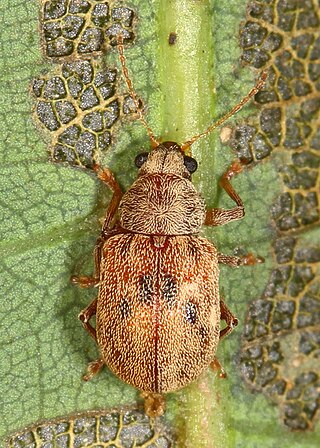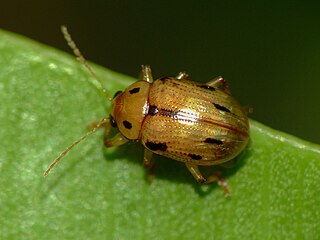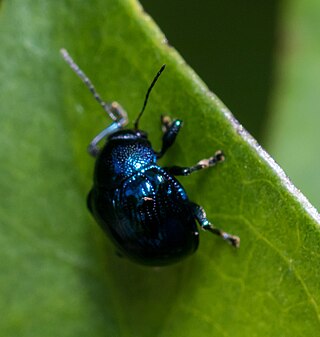
Colaspoides is a genus of leaf beetles in the subfamily Eumolpinae. It is one of the largest genera in the subfamily, containing over 260 species worldwide. It is an extant genus but there is at least one species, C. eocenicus, found in Baltic amber from the Upper Eocene of Russia, and the genus has also been reported from the Miocene of the Dominican Republic.
Taophila is a genus of leaf beetles in the subfamily Eumolpinae. The genus is endemic to New Caledonia.

Eumolpini is a tribe of leaf beetles in the subfamily Eumolpinae. It is the largest tribe in the subfamily, with approximately 170 genera found worldwide. Members of the tribe almost always have a longitudinal median groove on the pygidium, which possibly helps to keep the elytra locked at rest. They also generally have a subglabrous body, as well as appendiculate pretarsal claws.

Demotina is a genus of leaf beetles in the subfamily Eumolpinae. There are over 50 described species in Demotina. The genus is native to Asia, Australia and Oceania, though one species is an adventive species in the southeastern United States in North America. Some species are known to be parthenogenetic.

Typophorini is a tribe of leaf beetles in the subfamily Eumolpinae. The tribe contains approximately 100 genera, which are found worldwide. Members of the tribe are mainly characterized by notches on the tibiae of the middle and hind legs, which are sometimes referred to as antenna cleaners. They also generally have a subglabrous body, as well as bifid pretarsal claws.

Rhyparida is a genus of leaf beetles in the subfamily Eumolpinae. It is distributed in the Australasian and Indomalayan realms, though some species are also known from the African islands of Madagascar and Seychelles.
Dumbea is a genus of leaf beetles in the subfamily Eumolpinae. It is known from the South Province and Mont Panié of New Caledonia, and is named after Dumbéa, a town nearby Nouméa. This name was originally used by the French entomologist Charles Adolphe Albert Fauvel to house several species of Eumolpinae from New Caledonia, but Fauvel's Dumbea was unpublished and is a nomen nudum. The genus was established based on general proportions and body size, and may be polyphyletic or paraphyletic.
Montrouzierella is a genus of leaf beetles in the subfamily Eumolpinae. It is known from the South Province and Mont Panié of New Caledonia, and is named after Xavier Montrouzier, the pioneer entomologist of New Caledonia. The genus was established based on general proportions and body size, and may be polyphyletic or paraphyletic.
Tricliona is a genus of leaf beetles in the subfamily Eumolpinae. It contains at least 35 species, and is distributed from India and Southern China to the Philippines and New Guinea.

Eurydemus is a genus of leaf beetles in the subfamily Eumolpinae. It is known from Africa and Fiji.

Basilepta is a genus of leaf beetles in the subfamily Eumolpinae. It is generally distributed in Asia. A single species is also known from central Africa.

Cleorina is a genus of leaf beetles in the subfamily Eumolpinae. It is known from Australia and Asia.
Stethotes is a genus of leaf beetles in the subfamily Eumolpinae. It is distributed in Southeast Asia and the Western Pacific.

Dematochroma is a genus of leaf beetles in the subfamily Eumolpinae. It is mostly distributed in New Caledonia, though it is also found on Lord Howe Island, Norfolk Island, Timor and Vanuatu. Adult beetles are often found at night feeding on leaves, and the larvae eat roots.
Kumatoeides is a genus of leaf beetles in the subfamily Eumolpinae. The genus is endemic to New Caledonia. The genus was first erected in 2018 by Spanish entomologist Jesús Gómez-Zurita. The generic name is the Latin transliteration of the Greek adjective κυματοειδής, meaning "corrugated", referring to the regular striae on the elytra of the beetles.
Damelia is a genus of leaf beetles in the subfamily Eumolpinae. It is known from Fiji and Solomon Islands.
Tricholapita is a genus of leaf beetles in the subfamily Eumolpinae. The genus is endemic to New Caledonia.
Stygnobia is a genus of leaf beetles found in the Samoan Islands and Fiji. It is a member of the subfamily Eumolpinae.

Thasycles is a genus of leaf beetles in the subfamily Eumolpinae. It is endemic to New Caledonia. For a long time it was treated as a synonym of Dematochroma, until it was reinstated as a valid genus in 2022.










